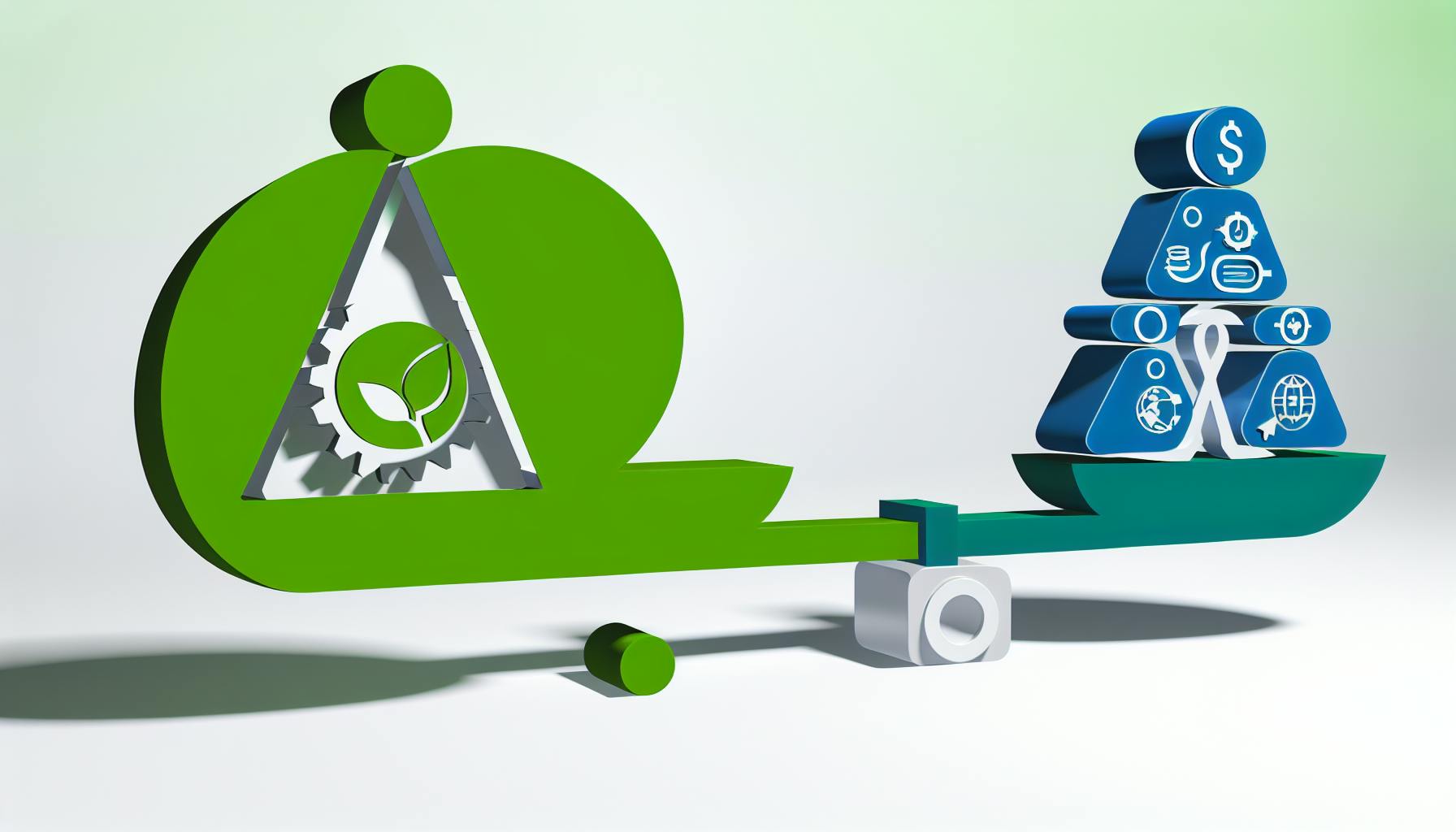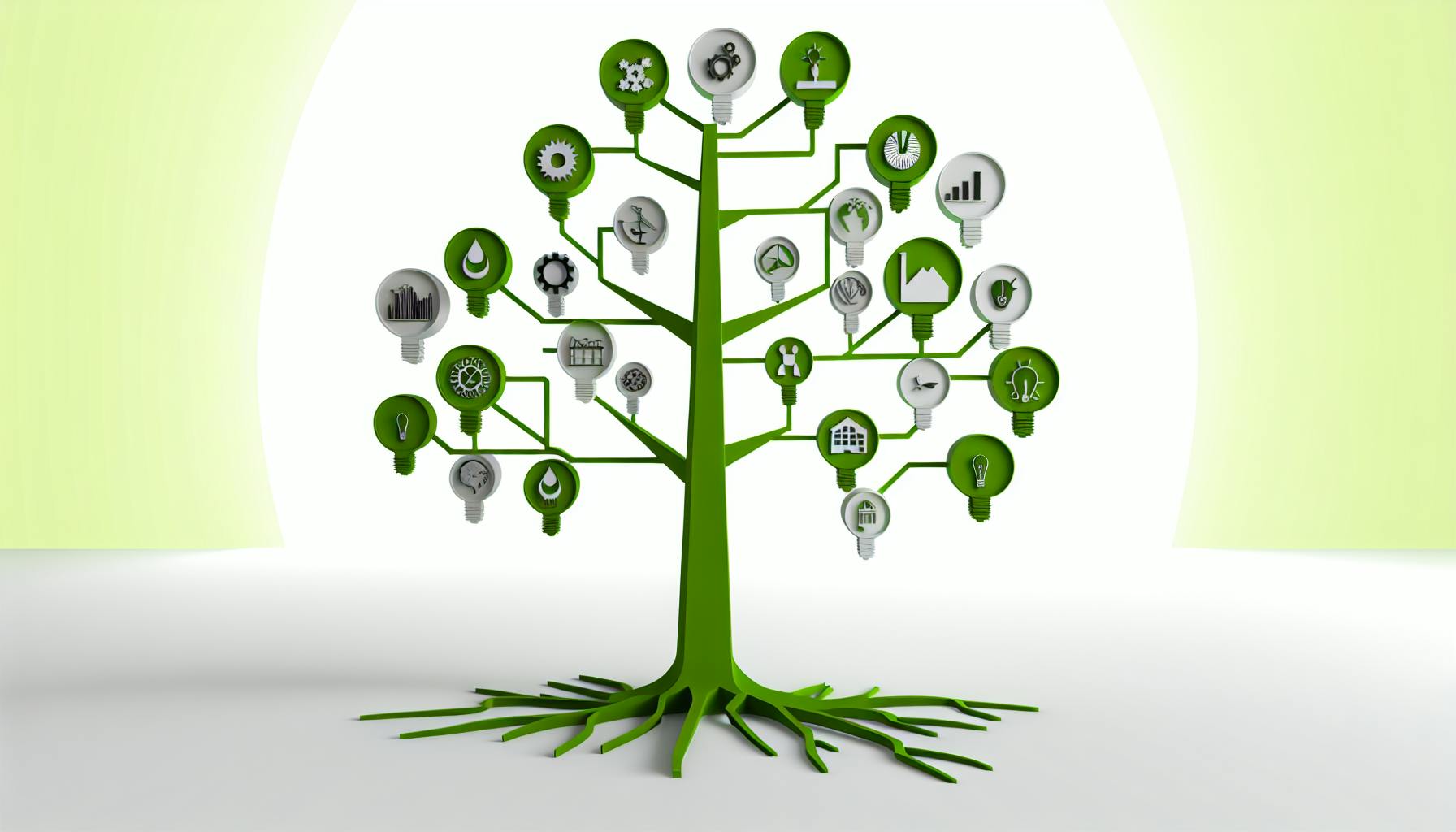Want to make your business more sustainable? Here's how to do a quick sustainability baseline assessment:
- Define what to assess
- Collect needed information
- Review current performance
- Set sustainability goals
- Create an action plan
This guide will walk you through each step to:
- Understand where your business stands on sustainability
- Identify areas for improvement
- Set realistic goals
- Create a plan to achieve them
Key benefits:
- Spot ways to cut waste and boost efficiency
- Meet growing customer demand for eco-friendly companies
- Save money through reduced energy use
- Stay ahead of new sustainability regulations
- Attract talent and investors who value sustainability
| Step | What to Do | Why It Matters |
|---|---|---|
| 1. Define | Pick key areas like energy use, waste, emissions | Focuses your efforts |
| 2. Collect | Gather data from bills, records, logs | Provides accurate starting point |
| 3. Review | Compare your numbers to industry averages | Shows where you can improve |
| 4. Set Goals | Create SMART goals for short and long-term | Gives clear targets to aim for |
| 5. Plan | Assign tasks, set deadlines, track progress | Turns goals into action |
Ready to start your sustainability journey? Let's dive in.
Sustainability Strategy Planning:
Define What to Assess
Picking the right areas to assess is crucial for your sustainability baseline. This step shapes your entire sustainability journey.
Focus Areas
Choose key sustainability areas for your business:
- Energy use
- Waste management
- Greenhouse gas emissions
- Water use
- Supply chain practices
RPM International Inc., a $6.1-billion specialty coatings company, focuses on:
Carbon footprint, energy efficiency, employee health and safety, product safety, business ethics, board diversity, and inclusion efforts.
Set Boundaries
Decide what's in and out of your assessment:
| Include | Exclude |
|---|---|
| Direct operations | Customer product use |
| Owned facilities | Outsourced services |
| Company vehicles | Employee commutes |
| Major suppliers | One-time vendors |
Choose Data Timeframe
Pick a timeframe that fits your business. Most use a full year of data.
| Timeframe | Pros | Cons |
|---|---|---|
| 1 year | Covers seasonal changes | Misses long-term trends |
| 3 years | Shows trends over time | Complex data collection |
| 5 years | Good for long-term planning | May not reflect recent changes |
Match your assessment period to your fiscal year for easier reporting.
Track all supply chain parts for a complete impact picture. As you collect data, you'll find areas to cut waste and boost efficiency.
2. Collect needed information
To build a solid sustainability baseline, you need the right data. Here's how to get it:
Record current practices
List what you're already doing for sustainability. This shows where you stand.
A retail store owner told us:
"We spend 10 minutes weekly jotting down sustainability ideas. We also ask 4 employees for feedback monthly. This tracks our progress and sparks new ideas."
Find data sources and how to measure
Identify your data sources and measurement methods. Look at:
- Utility bills (energy and water use)
- Waste management records
- Transport logs (emissions)
- Supplier information
Tip: Use a spreadsheet to organise your data by type. Update it monthly with your bills.
Check data is correct
Make sure your data is accurate:
1. Use standard units (kWh for energy, metric tons for waste)
2. Cross-check numbers with multiple sources when possible
3. Set up regular reviews
Good data leads to good decisions. A sustainability manager said:
"You need reliable data, efficient processes, and analytical skills to track sustainability performance and share results with stakeholders."
3. Review current performance
Time to crunch those numbers. Let's see where you stand on sustainability.
Baseline numbers
Calculate your current figures:
- Energy use: 50,000 kWh/year
- Water consumption: 1,000,000 L/year
- Waste generated: 10 metric tons/month
These are your starting points. Now, let's see how you stack up.
Industry comparison
How do you measure up? Let's use the Global Reporting Initiative (GRI) framework. It's the go-to for 73% of the world's 250 largest companies across 100+ countries.
| Area | You | Industry Average |
|---|---|---|
| Energy use | 50,000 kWh/year | 45,000 kWh/year |
| Water use | 1,000,000 L/year | 900,000 L/year |
| Waste | 10 metric tons/month | 8 metric tons/month |
Spot the differences? That's where the work begins.
Strengths and weaknesses
Time for a Sustainability SWOT. It'll show you what's working and what's not:
- Strength: Low energy use in office lighting
- Weakness: High water consumption in production
- Opportunity: Switch to renewable energy
- Threat: New waste management regulations
This analysis? It's your roadmap for improvement. Use it to focus your efforts where they'll make the biggest impact.
sbb-itb-919600f
4. Set sustainability goals
You've got a clear picture of where you stand. Now, let's set some goals that pack a punch.
Make SMART goals
SMART goals are your roadmap:
- Specific: Nail down what you want to do
- Measurable: Use numbers to track progress
- Achievable: Keep it realistic
- Relevant: Make it fit your business
- Time-bound: Set a deadline
Here's a real example:
WashREIT, a real estate investment trust, aims to cut energy use and greenhouse gas emissions by 20% by 2025. It's specific, measurable, achievable, relevant, and time-bound.
Align with company plans
Your sustainability goals should mesh with your business strategy. If they don't, you're asking for trouble.
| Business Goal | Sustainability Goal |
|---|---|
| Boost profit margins | Cut energy costs by 15% |
| Grow market share | Launch eco-friendly products |
| Enhance brand image | Go carbon neutral by 2030 |
Mix short-term and long-term targets
Don't put all your eggs in one basket. Aim for quick wins and big dreams.
Short-term (1-2 years):
- Switch to LED lighting
- Start recycling
- Train staff on energy-saving
Long-term (3-5 years):
- Install solar panels for 50% of energy needs
- Develop closed-loop manufacturing
- Get B Corp certified
Keep these goals flexible. Review and tweak as you go. The UN says we need to halve annual greenhouse gas emissions in eight years. It's a big ask, but every step counts.
"Your long-term target is great – but who's still going to be around to check that you're actually doing that in 2050?" - Karen Ermel, Associate Director of Responsible Investing at Coutts
Karen's right. That's why short-term goals are key. They keep you honest and on track.
5. Create an action plan
You've set your goals. Now, let's map out how to reach them. Your action plan is your roadmap to sustainability success.
Plan how to improve
Break down your goals into smaller steps. For each goal, list the actions needed.
Let's say you want to cut energy use by 15%. Your plan might look like this:
- Switch to LEDs
- Install smart thermostats
- Upgrade to energy-efficient appliances
Don't forget about resources. Think money, time, and people.
Assign tasks and deadlines
Who's doing what? When? Be clear about responsibilities.
| Task | Person | Deadline |
|---|---|---|
| LED swap | Sarah (Facilities) | June 30 |
| Smart thermostats | Tom (IT) | August 15 |
| Appliance upgrade | Mark (Purchasing) | December 1 |
Make sure everyone knows their job and deadlines. It keeps things moving and helps track progress.
Set up ways to track progress
Create a system to monitor your efforts. It shows what's working and what's not.
Try these:
- Weekly check-ins
- Monthly reports
- Quarterly reviews
"To achieve ambitious targets, you will need to create an action plan that helps break the ambitious targets down into steps that are more within reach." - Kevin Moss, Chief of Institutional Alignment of the World Resource Institute (WRI)
Your action plan is your guide. Use it to stay on track and make your sustainability goals a reality.
Conclusion
Let's recap the five steps for a sustainability baseline assessment:
- Define what to assess
- Collect needed information
- Review current performance
- Set sustainability goals
- Create an action plan
Each step builds on the last, creating a solid foundation for your sustainability efforts. This process gives you a clear starting point and direction for your company's sustainability journey.
But don't stop there. Your initial assessment is just the beginning. Here's why ongoing improvement matters:
- Stay current: Update your assessment yearly as your business evolves.
- Find new opportunities: Regular reviews can uncover ways to boost efficiency and cut costs.
- Improve your data: Each assessment cycle leads to more accurate data and smarter decisions.
- Engage employees: Get your team involved. Ask for ideas from every department.
| Action | Frequency | Benefit |
|---|---|---|
| Update assessment | Yearly | Keep up with business changes |
| Review goals | Quarterly | Track progress and adjust |
| Gather feedback | Monthly | Find new areas to improve |
| Train employees | Ongoing | Build a sustainability culture |
"Sustainability reporting keeps an organisation moving forward, growing in all the right ways." - Rob Smallcombe, Founder EcoHedge
FAQs
How do you conduct a sustainability assessment?
Here's how to do a sustainability assessment:
- Pick key metrics (like energy use and waste)
- Use tools (like life cycle assessment)
- Get qualitative data (through stakeholder interviews)
"A sustainability baseline assessment is the best way to set up a solid foundation for your planning - whether it's your first Sustainability Plan or an update." - The Sustainability Consortium
What is a baseline assessment in sustainability?
A sustainability baseline assessment is your starting point. It helps you:
- See where you are now
- Set goals you can actually reach
- Keep track of how you're doing
It's like taking a snapshot of your business right now. This snapshot helps you make smart choices about what to improve next.
| What to Assess | Why It Matters |
|---|---|
| Energy use | See where you're using too much |
| Waste | Find ways to cut down |
| What people think | Learn what's important to others |
| Environmental impact | Understand how you affect the planet |



